5 Myths and 5 Truths about Body Image, Food, and Weight
8th November 2022 | Author: Bianca Skilbeck
.jpg)
There's a lot of myths and misconceptions out there about what body image is and how to improve it. There's even more well-worn advice that let's face it; just doesn't work. Therefore, I've put together this list to help you on your journey to improving body image. Enjoy!
Myth 1. The solution to body image issues is to change your body
The solution to experiencing any form or amount of body image distress has never been to focus on making changes to your body. If you think about it, it’s all in the name; body image. Your body image is the picture that you have in your mind of your body; both in terms of how it looks and how it functions. How your body looks or functions is likely to be not entirely, or in some cases at all changeable. Does this mean that you can’t improve your body image? Of course not. Because body image is a psychological and emotional experience. Even if the look or function of your body is changeable, it’s still not the first place to start. Many people can relate to that experience of thinking that they will be happy ‘when’ they get to a certain goal, weight, size, or other bodily change, only to find that when said goal arrives, the goal posts have shifted. Focus on how you can get happy with your body now. Focus on self-acceptance and compassion as the first step to improving body image.
Myth 2. It is important to ‘love’ your body
“Body Positivity” tells us that we need to love our bodies in order to improve body image. However, the body positivity that we know from Instagram today looks quite different to its beginnings. The roots of body positivity can be found in the 1960’s with radical fat activism which was most often led by ethnic minority women and other minorities. These groups protested the kind of structural bias and inequity within fashion, beauty, the healthcare system, and society, which led to the oppression and discrimination of those who did not meet the narrow definitions of “the beauty ideal.” I.e., thin, white, cis-gender, and able-bodied. The original message of body positivity had very little to do with whether or not you love your body, and by extension, whether or not you love how your body looks. “Loving” how you look was never the point, because what has loving your body got to do with the fact that your body deserves respect, appreciation, care, and equal treatment? For many people, the distorted message of today’s body positivity just takes them further away from a healthy relationship with their body. Whilst loving your body may on one level seem like a positive goal, for many who struggle with body image, “loving their body,” is just another thing that they cannot get right. Yet we do not need to love how our body looks in order to respect, appreciate, and care for it. If body love feels too hard, try instead body care, body respect, body appreciation, or body kindness. For many, these are much more fruitful goals in improving their relationship with their body.
Myth 3. You can ‘choose’ your goal weight, and stay there
Diet culture and the companies that operate within it will tell you that you can pick a goal weight and stay there. That permanent weight loss is possible, easy, and that you should sign up to their product, program, or intervention to achieve it. Nonetheless, the science simply cannot help but bear out the ultimate failures of this message. In a big study (below) looking at several different weight loss interventions, we see that the exercise alone and meal replacement groups were not followed up beyond 12-months; a typical approach (and red flag) in weight loss studies. With arrows pointing upwards, it’s not hard to extrapolate to where those arrows likely went in time. At 24 months, the Sibutramine drug group was discontinued. Possibly because the drug was discontinued in most countries due to the increased risk of cardiovascular event and stroke. We see the horrendous failure of the very low-calorie diet, again with the arrow pointing dramatically upwards. In fact, with the exception of diet alone, all of the arrows point upwards. The point being that any results obtained, are rarely sustained. Even the diet alone group, for all of the effort put in, only managed to achieve a 4kg loss over 4 years; yet let’s not omit that these results will not account for anyone who dropped out of the study or who could not be contacted for follow up. In other words, these results are the best of the best.
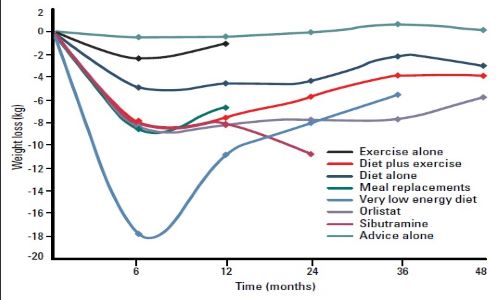
The point? It’s not rocket science that if you reduce calorie intake, weight loss will ensue. The better questions you should be asking, however, is: Are the losses sustained? Is the method safe? Is the attempt at weight loss actually as ‘harmless’ as we are led to believe? The answers are no, no, and no, leading to the next point….
Myth 4. Attempting to control or change your body is harmless
You may read all the above and think, so dieting is rarely successful, but it’s still worth a try. What’s the harm? And look, we’re not here to tell you what you should do with your body; it is your body and your choice. Yet the risks of dieting are many and they are rarely mentioned, so here goes. It is well documented in scientific literature that up to 95% of people who lose weight through dieting will put that weight back on; some estimates suggesting that roughly a third of people will put the weight back on, plus a bit more (hence those upwards arrows in the study above). This puts many people at a risk of ‘yo-yo dieting,’ or what is known in the literature as ‘weight cycling’. The issue with weight cycling is that it is a known risk factor that contributes to inflammation in the body. This begs the question; what if many of the chronic diseases and illnesses that get blamed on ‘fatness’ are actually being caused by the inherent dieting and weight cycling that many people in larger bodies have been compelled to do, or told to do? Then, as if the physical risks aren’t enough to consider, there is the mental, emotional, and social impacts of yo-yo dieting, weight cycling, and the risks of developing an eating disorder. Some estimates say that 20-25% of people who diet will go on to develop some type of disordered eating. These statistics don’t even begin to speak to the toll that all of the above have on body image, self-perception, and self-esteem. The risks of yet another dieting attempt are really starting to add up….
Myth 5. You need to lose weight to improve your health
You might read all of the above and think sure, dieting rarely works, but you still need to lose weight to be healthy, right? Well, perhaps not. A 2012 study looking at almost 12,000 people over the course of 14 years showed that lifestyle, a.k.a “healthy habits”, may well be more important than weight as a standalone measure. To come to this conclusion, the study broke people up into three BMI categories of ‘normal weight’, ‘overweight’, and ‘obese’, and then looked at the hazard ratio (in this case, the likelihood of death) based on the number of “healthy habits” the person consistently implemented. Healthy habits were defined as eating 5 or more fruits and vegetables daily, exercising regularly, consuming alcohol in moderation, and not smoking. What the study found (shown below), was that the more healthy habits a person engaged with, the lower their risk of death. To the point that when people regularly engaged in all four healthy habits, their risk evened out to about the same amount irrespective of their weight.
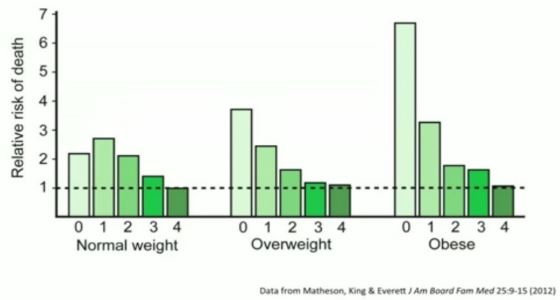
Surprised? It’s not quite the story that we’re told is it? As it turns out, no matter your current weight, you can improve your health and risk of early death from chronic disease by simply changing your habits, even when those habits don’t necessarily change your weight. The moral of the story here is that if you want to improve your health, your best bet is to forget the scales and just get down to focusing on the healthy habits that are achievable for you.
Truth 1. There are many factors that contribute to weight and health
We all know, at least on some level, that there are many factors which determine a person’s weight, shape, size, and overall health. Nonetheless, it deserves a special mention, because despite this very rational and logical fact, diet and wellness culture continue to tell (and sell) us that if we ‘just’ modify what we are doing with our lifestyle, then we can become the weight, shape, size, or state of health that we want. Yet that is just not the truth. Research looking at the socioeconomic determinants of health identifies that roughly only 36% of our health outcomes can be attributed to individual lifestyle factors (things like diet, sleep, physical movement, individual psychological factors, drug use, etc.). The rest is made up of social circumstances (gender, relationships, education, occupation, income, etc.), genetic or biological factors, physical environment (air quality, job opportunity, crime level, etc.), and medical care. What this means is that yes, we do have some control over health outcomes and of course it is worth focusing on improving what we can. Yet, our weight and health outcomes are reliant on a picture much bigger than just the individual person.
Truth 2. There is a good chance you will need to work on internalised fat-phobia
One of the core drivers for eating disorders and body image distress for many people, on some level, is a fear of getting fat, staying fat, or just fat in general. “Fat-phobia” is the term for this, and it exists at a few different levels. Systemic and interpersonal fat-phobia are particularly heinous because they build discrimination and oppression into the very fabric of our society and our relationships. Internalised fat-phobia is insidious, because it tends to hide in many of the unexamined nooks and crannies of our minds. It is so deeply ingrained for many people that we can’t even see it, and it hurts us in the form of body image distress, eating disorders, and disordered eating. It wreaks havoc with our relationship with food. Then, when we’re not careful, it leaks out onto the people around us. Yet, what we most often fail to recognise, is that ‘fat’ is neutral. As a part of our body composition it is neutral (we all need it to survive), and as a descriptor of a body it is neutral (we all come in different sizes and shapes, that’s what body diversity is). If we are to improve our body image, we need to recognise that this fear is a socially constructed one. It is not intrinsic to our nature.
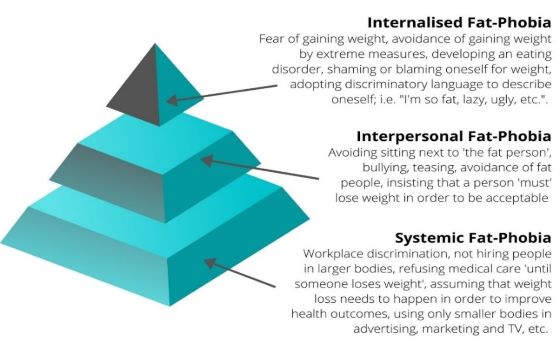
Truth 3 . Your doctor does not always know what is best for you
Doctors and medical professionals train incredibly hard and long to do what they do. Most work as tirelessly as they do because they care about making a difference. Nonetheless, doctors are human and they also live within the confines of fat-phobia, and the resulting “weight stigma.” The reality is that a great deal of medical research looking at weight and health outcomes is incredibly biased before it even begins. Many research questions simply ‘assume’ that fat is bad, and from there, try to figure out “how and why” without examining the premise, or questioning how attitudes to weight may actually affect outcomes. What this translates to in clinical settings is unexamined assumptions about weight and health. This can lead to discriminatory or shaming treatment which ignores the impact of mental health and disordered eating. It can lead to misdiagnosis, health advice that is difficult or impossible to follow, and ultimately, medical avoidance. Doctors and medical practitioners are the experts in their field, but they are not the experts of your body. They are not the experts of your lived experience, or the knowledge that you have about living in your body, or having your relationship with food. It is okay to look for a new doctor who you feel understands you better. It is okay to ask that you not be weighed at regular appointments, or to have your weight as a focus of ‘treatment.’ It is okay to speak up on behalf of your mental health.
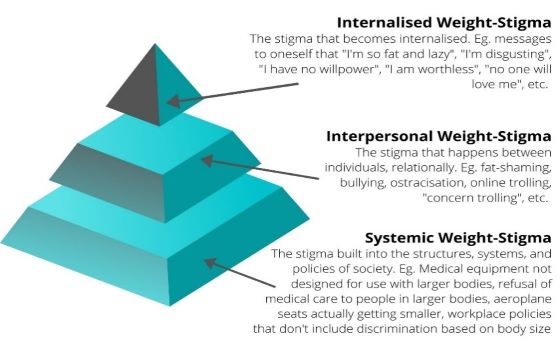
Truth 4. “Body grief” is normal, and should be normalised
We’ve spent so long fighting our bodies. Maybe we’ve been fighting our weight or some other aspect of our appearance. Maybe it’s chronic illness, injury, or disability. Or the inevitable process of ageing that we will all succumb to if we are so lucky. Many times when a person enters therapy for anything related to a body image issue, they remark on how they ‘have tried everything’ to fix this. What frequently becomes clear through a process of reflection, however, is that they’ve tried everything except moving through the full stage of the cycle of grief, all the way to acceptance. It may sound like a strange way to think of our relationship with body image, in the context of the grief cycle? Yet, when we look at the cycle, it makes complete sense. We live in denial of the things which we may not be able to change. We feel angry, we might even take out that anger on ourselves. We bargain; just another diet, another product, another intervention of some kind. We find ourselves sad, depressed even, when the most recent of these attempts fail. Ultimately, we find ourselves with no other choice but to find some acceptance, unless we want to spend our lives fighting. It is important to understand that “body grief” is normal if we are to find self-acceptance. What we are most often grieving is what we have been conditioned by diet or even wellness culture to believe we ‘should’ be. We are letting go of those unrealistic and harmful beauty and body standards that have hurt us for so long.
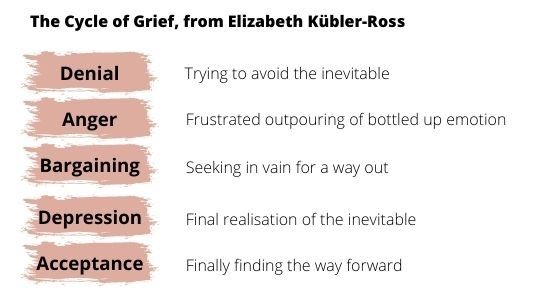
Truth 5. Your ‘inner rebel’ might be your best ally in your body image journey
These myths and truths have been a lot to take, haven’t they? First, we’re told not to focus on changing our bodies; that in fact, the goal of ‘body love’ may be leading us astray. Then we discover just how unrealistic and unfair it is to expect our bodies to change, specifically, to lose weight, when the science shows how statistically unlikely it is that that will happen over the long term. Yet, we can be relieved to understand that there are so many things that we can do to improve our health without weight loss, and that weight, shape, and health are ultimately determined by so many factors that aren’t even in our control. We can begin to understand that fat-phobia may be ruling the show; internalised as well as interpersonal and systemic, and we can be empowered to know that this need not be the case forever. We can find ways to treat ourselves with respect and kindness. We can find medical practitioners who treat us with dignity and care, and more than just a number on a scale. We can embrace the cycle of grief and begin our life’s work of moving towards acceptance. Yet, let’s face it; these ideas are kind of counter-culture, aren’t they? We’re not told by the mainstream messages in society that we should accept and be kind to ourselves. Yet it is our only choice if we are to find freedom. Ultimately, to fully dive in and heal our relationship with our bodies, we may have to summon up just a little bit of the energy of our inner rebels. To go against the mainstream. So, the question is; are you up to the challenge?
Would you like a copy of this post to download and share with your friends, family, or clients? Click on the link below
References & Further Reading
Anderson, A. (2020). The Problem with Dieting: Eating Disorders Affecting American College Students. School of Public Health. https://sph.umich.edu/pursuit/2020posts/the-problem-with-dieting-eating-disorders-affecting-american-college-students.html
Go Invo. (2020). Determinants of Health. https://www.goinvo.com/vision/determinants-of-health/
Grima, M., & Dixon, J. B. (2013). Obesity recommendations for management in general practice and beyond. Australian family physician, 42, 532–541.
Matheson, E. M., King, D. E., & Everett, C. J. (2012). Healthy Lifestyle Habits and Mortality in Overweight and Obese Individuals. The Journal of the American Board of Family Medicine, 25, 9–15.
NEDC (n.d.). “Disordered Eating and Dieting”. https://nedc.com.au/eating-disorders/eating-disorders-explained/disordered-eating-and-dieting/
Phelan, S. M., Burgess, D. J., Yeazel, M. W., Hellerstedt, W. L., Griffin, J. M., & van Ryn, M. (2015). Impact of weight bias and stigma on quality of care and outcomes for patients with obesity. Obesity reviews: an official journal of the International Association for the Study of Obesity, 16, 319–326. https://doi.org/10.1111/obr.12266
Puhl, R. M., & Heuer, C. A. (2010). Obesity stigma: important considerations for public health. American journal of public health, 100, 1019–1028. https://doi.org/10.2105/AJPH.2009.159491
The Butterfly Foundation (2012). Paying the Price: The economic and social impact of eating disorders in Australia. https://thebutterflyfoundation.org.au/assets/Uploads/Advocacy/Butterfly-Report-PayingthePrice.pdf
The Conversation (2022). Why the body positivity movement risks turning toxic. https://theconversation.com/why-the-body-positivity-movement-risks-turning-toxic-189913
Tomiyama, A., Carr, D., Granberg, E., Major, B., Robinson, E., Sutin, A. R. & Brewis, A. (2018). How and why weight stigma drives the obesity ‘epidemic’ and harms health. BMC Med, 16, 123. https://doi.org/10.1186/s12916-018-1116-5
Yes Solutions Journalism (2018, Nov 8). “The Fear of Fat: Our Last Acceptable Bias”. https://www.yesmagazine.org/social-justice/2019/11/08/fat-bias-fear-weight-stigma/


.jpeg)










